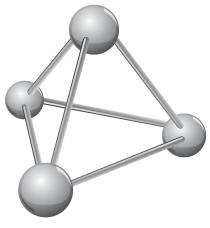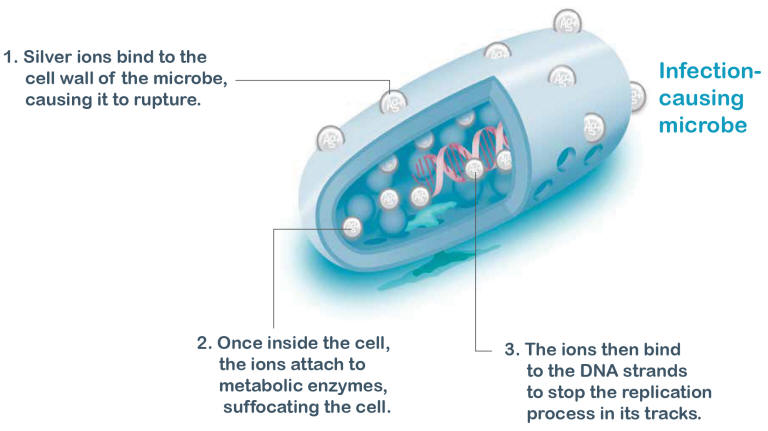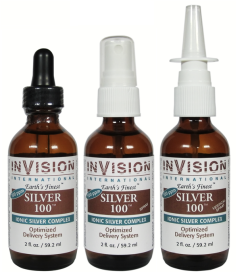Colloidal Silver vs. Ionic Silver
| |
 |
| |
simple silver
molecule |
Silver is one of the single most effective antiviral and bactericidal agents known! Specifically, silver
ions complement the body’s immune system by providing exceptional protection against pathogenic bacteria, fungi, and viruses.
Silver works as a catalyst, disabling the enzyme that one-celled bacteria, fungi and viruses use for their metabolism. Because no known disease-causing organism can live in the presence of even minute traces of silver,
silver is effective against more than 650 different disease-causing pathogens.
Pharmaceutical antibiotics are only effective against about a dozen forms of bacteria and fungi, and never viruses!)
Unlike with pharmaceutical antibiotics, resistant strains have never been known to develop.
(no 'super bugs!')
Colloidal silver is non-toxic, non-addictive and has no side effects. The body develops no tolerance and one cannot overdose. Colloidal Silver cannot cause harm to the liver, kidneys or any other organ in the body.
Silver is safe for pregnant and nursing women and even aids the developing fetus in growth and health as well as easing the mother's delivery and recovery. Water-soluble silver is the perfect natural alternative to synthetic antibiotics and is wonderful for both adults and children of all ages. Colloidal silver is odorless, tasteless, non-stinging, harmless to eyes, contains no free radicals, is harmless to human enzymes and has no reaction with other medications. It improves digestion, aids in the regeneration of damaged cells and tissues, helps prevent colds, flu and organism caused diseases. Normal use of colloidal silver does not harm the beneficial bacteria in our intestines. Therefore, it does not cause an upset stomach or yeast growth commonly seen with traditional pharmaceutical antibiotics.
What is colloidal silver exactly?
C olloidal silver
– A solution containing pure water and nanometer sized silver particles
held in suspension.
Colloidal Silver is the result of an electromagnetic process that
pulls microscopic particles of silver from a larger piece of pure
silver into water. These particles are held in suspension by
the tiny electric charge on each atom, which causes an electrostatic mutual repulsion of the particles. This particle charge is due to adsorption of ions from the surrounding solution and is called zeta potential.
Most colloidal silver colloids also contain silver ions. Typically, the silver in ionic form constitutes 90% or more of the
total silver in solution. If the solution contains only particles and no ions, it
is considered to be a pure colloid.
What is ionic silver?
I onic silver
- A solution consisting of water and silver ions and contains NO silver particles. The ions in solution remain dispersed due to mutual repulsion created by the ionic charge.
True ionic silver solutions have a metallic taste which is quite pronounced in high concentrations.
Pure
100% Ionic silver solutions are products whose silver content is all
ions and no particles. (completely dissolved, like
Silver100)
The total silver content is divided into two forms of silver; ionic
silver and silver particles. The total silver content is
expressed as milligrams of silver per liter (mg/L) of water, which
is numerically the same as parts per million (ppm).
Ionic Silver is a step forward from Colloidal Silver.
The 'particle' size is so small that nothing can be observed under an electron microscope! Ionic silver is a solution consisting of water and
single atom silver ions (dissolved silver) and contains
no physical silver particles. Ionic silver is
conductive and the electrical conductivity is directly related to the ionic concentration. The ions in solution remain dispersed due to mutual repulsion created by the ionic charge.
When colloidal silver is stored over a period of time, the particles tend to agglomerate (clog) and build even larger clusters... which then reduces the amount amount of useful
silver ions, thereby reducing the silver's effectiveness. (This problem with colloidal silver is illustrated
here.)
Look at the pictures of Colloidal Silver on an electron microscope here.
Often, when colloidal silver is stored over a period of time, the particles agglomerate (chunk
together) and build even larger clusters as seen here. (an
electron microscope picture of a standard commercial Colloidal
Silver brand)
This does not occur with
Silver 100 Ionic Silver,
a truly remarkable ionic silver product that overcomes all
limitations of regular colloidal silver products.
|
A Few More
Definitions
zeta potential - Zeta potential is a measure of the magnitude of the repulsion or attraction between particles. Most particles in a polar medium such as water will possess a surface charge. A charged particle will attract ions of the opposite charge in the dispersant, forming a strongly bounded layer close to the surface of the particle. Those ions further away from the core particle make up a diffuse layer, more loosely bound to the particle. Within this diffuse layer is a notional boundary, inside which the particle and its associated ions act as a single entity, diffusing through the dispersion together.
The plane at this boundary is known as the surface of hydrodynamic shear, or the slipping plane . The potential at this boundary is known as the zeta potential. It is important to note that the magnitude of the zeta potential is affected by both the nature of the surface of the particle, and the composition of the dispersant . Zeta potential is affected by pH.
Zeta potential is an important property of colloidal solutions and is essential to the understanding of colloid stability .
The zeta potential of silver colloidal solutions has been measured to be between –15 mV to –60 mV.
- For a complete list of
silver related terms and the process by which
colloidal silver and ionic silver are made,
visit:
|
Silver Used Throughout History
Silver has long had acclaim in wellness from those seeking to maintain a healthy lifestyle. The medicinal benefits of silver have been known for
1000's of years. Here are just a few well known samples...
- The Greeks used silver vessels to keep water and other liquids fresh. The writings of Herodotus, the Greek philosopher and historian, date the use of silver to before the birth of Christ.
The Roman Empire stored wine in silver urns to prevent spoilage.
The use of silver is mentioned in ancient Egyptian writings.
In the Middle Ages, silverware protected the wealthy from the full brunt of the plague.
Before the advent of modern germicides and antibiotics, it was known that disease-causing pathogens could not survive in the presence of silver. Consequently, silver was used in dishware, drinking vessels and eating utensils.
The Chinese emperors and their courts ate with silver chopsticks.
The Druids left evidence of their use of silver.
Settlers in the Australian outback suspended silverware in their water tanks to retard spoilage.
Pioneers trekking across the American West found that if they placed silver coins in their casks of drinking water, it kept the water safe from bacteria, algae, etc.
All along the frontier, silver dollars were put in milk to keep it fresh. Some of us remember our grandparents doing the same.
Silver leaf was used to combat infection in wounds sustained by troops during World War I.
Prior to the introduction of antibiotics, Colloidal Silver was used widely in hospitals and has been known as a bactericide for at least 1200 years.
In the early 1800s, doctors used silver sutures in surgical wounds with very successful results.
For many years there was a law requiring hospitals to use a silver solution in the eyes of newborn babies to ensure they would not go blind should the mother have gonorrhea.
In Ayurvedic medicine, silver is used in small amounts as a tonic, elixir or rejuvenative agent for patients debilitated by age or disease.
How Does Silver Work? (more)
According to medical journals from around the world, it disables the particular enzyme that all one-celled bacteria, fungi and viruses use for their metabolism
(of sugar). Colloidal silver co-mingles with the blood and then
silver ions (supplied by the silver colloids) begin to enter the cells to seek out and destroy harmful organisms. It suffocates them in six minutes
or less after initial contact. This phenomenon was demonstrated in tests at
a UCLA Medical Lab. Trace amounts protect and strengthen the immune system. The pathogen suffocates and dies and is cleared out of the body by the immune, lymphatic and elimination systems.
Unlike pharmaceutical antibiotics which destroy beneficial enzymes
and bacteria, colloidal silver leaves these tissue-cell enzymes intact, as they are radically different from the enzymes of primitive single-celled life.
Since silver only kills anaerobic (non-oxygen breathing) bacteria,
viruses and fungus, the friendly bacteria in the digestive tract are
largely unaffected, because they are aerobic (oxygen breathing).
Colloidal silver is absolutely safe
for humans, pets, and plants.
|
How does colloidal silver work?
(Further Insights)
Richard Davies and Samuel Etris of The Silver Institute, in a 1996 monograph entitled The Development and Functions of Silver in Water Purification and Disease Control, discuss
three mechanisms of deactivation that silver utilizes to incapacitate disease causing organisms. They are
Catalytic Oxidation, Reaction with Cell Membranes, and
Binding with the DNA of disease organisms to prevent unwinding.
Catalytic Oxidation:
Silver, in its atomic state, has the capacity to absorb oxygen and act as a catalyst to bring about oxidation. Atomic (nascent) oxygen absorbed onto the surface of silver ions in solution will readily react with the sulfhydryl (-S-H) groups surrounding the surface of bacteria or viruses to remove the hydrogen atoms (as water), causing the sulfur atoms to form an R-S-S-R bond; blocking respiration and causing the bacteria to expire. Employing a simple catalytic reduction/oxidation reaction, colloidal silver will react with any negative charge presented by the organism's transport or membrane proteins and deactivate them.
Reaction with Bacterial Cell Membranes:
There is evidence that silver ions attach to membrane surface radicals of bacteria, impairing cell respiration and blocking its energy transfer system. One explanation is based on the nature of enzyme construction: Specific enzymes are required for a given biochemical activity to take place. Enzyme molecules usually require a specific metallic atom as part of the molecular matrix in order to function. A metal of higher valance can replace a metal of lower valance in the enzyme complex, preventing the enzyme from functioning normally. Silver, with a valance of plus 2, can replace many metals with a lower, or equal valance that exhibit weaker atomic bonding properties.
Binding with DNA:
Studies by C.L. Fox and S.M. Modak with Pseudomonas aeruginosa, a tenacious bacteria that is difficult to treat, demonstrated that as much as 12% of silver is taken up by the organism's DNA. While it remains unclear exactly how the silver binds to the DNA without destroying the hydrogen bonds holding the lattice together, it nevertheless prevents the DNA from
unwinding, an essential step for cellular replication to occur.
|

When Is It Used?
Here is a small sample of diseases that colloidal silver has been used successfully:
acne, allergies, appendicitis, arthritis, blood parasites, bubonic plague, burns, cancer, candida, cholera, chronic fatigue, colds and flu, conjunctivitis, diabetes, gonorrhea, hay fever, herpes, leprosy, leukemia, lupus, Lyme disease, malaria, meningitis, parasitic infections both viral and fungal, pneumonia, rheumatism, ringworm, scarlet fever, septic conditions of the eyes, ears, mouth and throat, shingles, skin cancer, staph infections, strep infections, syphilis, toxemia, trench foot,
all forms of viruses, warts
What Doctor's Say About Silver
According to experts, no microorganism ever tested has been able to stay alive for more than six minutes when exposed directly to colloidal silver
(silver ions)!
| Dr. Harry Margraf, a biochemist and pioneering silver researcher who worked with the late Carl Moyer, M.D., chairman of Washington University's Department of Surgery in the 1970s:
"Silver is the best all-around germ fighter we have."
Science Digest cites colloidal silver as "...a wonder of modern medicine," and further states
"Antibiotics kill perhaps a half dozen different disease organisms, but silver kills some 650. Resistant strains fail to develop. Moreover, silver is non-toxic. Colloidal silver, used as an anti-microbial agent, will not create super bugs as antibiotics do."
Alfred Searle, founder of the giant Searle Pharmaceuticals (now Monsanto) stated,
"Applying colloidal silver to human subjects has been done in a large number of cases with astonishingly successful results. For internal administration ... it has the advantage being rapidly fatal to pathogens without toxic action on its host. It is quite stable." Further information indicates that Colloidal Silver does not cause harmful interactions with other medications or topical treatments.
In laboratory tests with colloidal silver, bacteria, viruses, and fungal organisms are killed within minutes of contact. Larry C. Ford, M.D. of the Department of Obstetrics and Gynecology, UCLA School of Medicine, Centre For The Health Sciences reported in November 1, 1988, " I tested them (the silver solutions) using standard anti-microbial tests for disinfectants. The silver solutions were anti-bacterial for concentrations of 105 organisms per ml of Streptococcus Pyogenes, Staphylococcus Aureus, Neisseria Gonorrhea, Gardnerella Vaginalis, Salmonella Typhi and other enteric pathogens, and fungicidal for Candida Albicans, Candida Globata and M. Furfur."
Dr. Robert O. Becker, MD, noted biomedical researcher from Syracuse University, and author of The Body Electric and Cross Currents, recognized a correlation between low silver levels and sickness. He said silver deficiency is responsible for the improper functioning of the immune system. “What we have done is rediscover the fact that silver killed bacteria, which had been known for centuries.” In the process of his work, Dr. Becker discovered that he had
wiped out types of bacteria across the board, even those that were resistant to antibiotics." Regarding the innate ability of metallic silver to control infection, Dr. Becker said: "all of the organisms that we tested were sensitive to the electrically generated silver ion, including some that were resistant to all known antibiotics." On the safety of silver, he said,
"in no case were any undesirable side effects of the silver treatment apparent."
Dr. Bart Flick of Argentum Medical LLC, another early pioneer in silver medical research, invented FDA approved Silverlon wound contact dressing. "The antimicrobial activity of silver rests upon the interaction of silver with the bacteria's cellular membrane. This interaction can occur through the presence of a silver ion in solution or the release of silver in an ionic moiety directly from the surface of metallic silver when a bacterial cell membrane comes in direct contact with the metallic surface."
Dr. Henry Crooks, author of
Use of Colloids in Health Disease, found that silver in the colloidal state is highly germicidal, quite harmless to humans and absolutely non-toxic. From his bacteriological experiments with silver he concluded,
"I know of no microbe that is not killed in laboratory experiments in six minutes."
Dr. Bjorn Nordenstrom, of the Larolinska Institute, Sweden, has successfully used silver as a component in his cancer treatments for many years.
Dr. Leonard Keene Hirschberg, A. M., M. D. (John Hopkins) states, "Speaking generally, the colloidal metals are especially remarkable for their beneficial action in infective states."
Dr. Richard L. Davies, executive director of the Silver Institute, which monitors silver technology in 37 countries, reports:
"In four years we've described 87 important new medical uses for silver. We're just beginning to see to what extent silver can relieve suffering."
Peter Lindemann reports in his 1997 article, Colloidal Silver, A Closer Look, that a study conducted in part by the Institute of Microbiology in Rome, Italy and published in
Applied and Environmental Microbiology (Dec. 1992), stated that "Pure electro-colloidal silver out- performed silver nitrate, silver chloride, and silver sulfadiazine as a broad spectrum germicide. For all classes of bacteria, fungus, and mold samples tested, pure electro-colloidal silver worked better, and at much lower concentrations. They concluded that
any additives reduced the effectiveness of the pure silver ion."
According to Dr. Evan of Illinois, Kansas
"We have had instant success with Colloidal Silver and immune compromised patients. A few examples are: Pink eye (topical) totally resolved in less than six hours; recurrent sinus infections (oral ingestion) resolved in eight days; acute cuticle infections resolved twenty four hours. Another major area in which we have improved our clinical results is in the area of
bowel detoxification and dysbiosis. The colloidal silver has provided excellent removal of abnormal intestinal bacteria also it has proved to be a great adjunct to our Candida albicans, Epstein Barr Virus and Chronic Fatigue Syndrome protocols.
|
 Silver100's Opti-Silver™ technology is a HUGE LEAP forward within the field of colloidal/ionic silver products! Silver100's Opti-Silver™ technology is a HUGE LEAP forward within the field of colloidal/ionic silver products!
Silver 100™ delivers silver ions to you in a
slow-release 100 parts per million solution! NO OTHER SILVER PRODUCT COMES CLOSE! Silver 100 contains Opti-Silver™ (ions of silver complexed with
citrate & potassium) for delivery of silver ions far more efficiently than any colloidal silver is capable of doing! It is used the same way as colloidal silver, but is designed to
efficiently deliver the smallest units of silver that exist in the world—ions—the size of atoms.
( 0.26 nanometer in size, far
smaller than any pathogen.
Smallest units of silver that exist: Delivers silver ions, 0. 26
nanometer in size, far smaller than any pathogen - See more at:
http://www.bettymills.com/shop/product/view/Invision%20International/HGR0782524.html?utm_source=cpc-strat&utm_medium=cpc&utm_campaign=parts&utm_keyword=HGR0782524&utm_content=Medical&gclid=CIDpquXRxMwCFQ2QaQodYEADiA#sthash.EryrYThb.dpuf
Smallest units of silver that exist: Delivers silver ions, 0. 26
nanometer in size, far smaller than any pathogen - See more at:
http://www.bettymills.com/shop/product/view/Invision%20International/HGR0782524.html?utm_source=cpc-strat&utm_medium=cpc&utm_campaign=parts&utm_keyword=HGR0782524&utm_content=Medical&gclid=CIDpquXRxMwCFQ2QaQodYEADiA#sthash.EryrYThb.dpuf

Smallest units of silver that exist: Delivers silver ions, 0. 26
nanometer in size, far smaller than any pathogen - See more at:
http://www.bettymills.com/shop/product/view/Invision%20International/HGR0782524.html?utm_source=cpc-strat&utm_medium=cpc&utm_campaign=parts&utm_keyword=HGR0782524&utm_content=Medical&gclid=CIDpquXRxMwCFQ2QaQodYEADiA#sthash.EryrYThb.dpuf
|
 Get your Silver 100™ now!
Silver is invaluable in fighting over 650 different pathogens! Get your Silver 100™ now!
Silver is invaluable in fighting over 650 different pathogens!
Drop for drop, ounce per ounce, Silver 100 is one of the
least expensive
silver's in the world to use!

Just $39.95!
|
.png)

Colloidal Silver
|